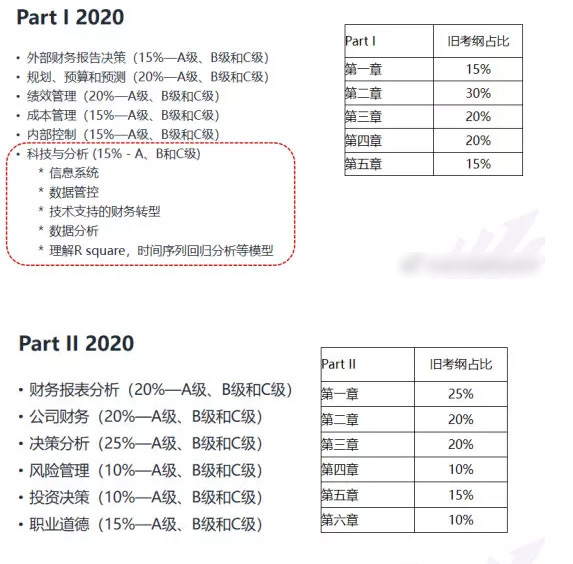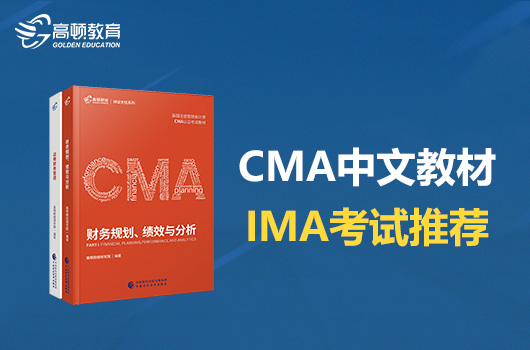以下内容大纲代表了CMA考试将涵盖的知识体系。当新的内容成为行业共识时,大纲将会随之更新。
CMA认证的考生必须参加并通过第一部分和第二部分的考试。考生有责任了解大纲所涵盖领域的最新进展。这包括理解会计组织发布的公开声明,以及了解当前会计,财务和商业期刊中有关报告的最新进展。
考试内容大纲有多项用途。本大纲旨在:奠定考试的基础。为每次考试范围的一致性提供基础。详述考试各部分的内容。协助考生准备各部分考试。
下面列出了有关内容大纲和考试的其他重要信息。
1.大纲中每个主题所占的百分比代表该主题在考试中的相对权重。每个主题的考题数量占总题量的比例与此权重相近。
2.考题的分布取决于所考察主题的相对权重。每个主题下的考点没有再次分配相对权重,不应根据考点的排列顺序或考点数量来推断其相对权重或重要性。
3.每个主题都有特定的难度水平,表示该主题所出题目的深度和广度,可以考
察从初级了解(A级难度)到透彻理解和应用的能力(C级难度)。关于考题的难度水平和对考生能力的具体要求,之后有详细的说明。
4.考点经过精心选择以尽量减少第一部分考试和第二部分考试内容的重叠。考题可涵盖本部分内的主题和主题内的相关考点。
5.关于美国联邦所得税的问题,考生在报告和分析财务结果时应理解所得税的影响。此外,还将测试影响决策(例如折旧,利息等)的有关税法规定。
6.CMA认证的考生也应了解财务报表编制,商业经济学,货币的时间价值,统计和概率的有关知识。
7.第一和第二部分考试分别为四小时,每个部分的考试包含一百个多项选择题和两个情境题。考生将有三个小时完成多项选择题,一个小时完成情境题。每项考试中含有少数供将来使用的测试题,这些题将不会计入最终得分。
8.情境题需要语言论述和计算解答。要求考生以合乎逻辑的方式回答问题,并证明对该问题的正确理解。为了更清楚地定义考生所需的考点知识,CMA考试对内容大纲中主要考点确定了不同层次的能力要求。成功的考生应具备的并将在考试中被测试的认知能力如下所示:
了解:记忆以前学过的材料,例如具体的事实,标准,技术,原则和过程(即识别,定义,列举)。
理解:掌握和解释材料含义的能力(即分类,解释,区分)。
应用:能够在新的和具体的情况下使用习得的材料(即证实,预测,解决,修改,关联)。
分析:能解构材料,理解其组织结构;能识别因果关系;区分行为,并识别与判断验证相关的元素(即区分,估计,排序)。
综合:能够将各部分放在一起形成一个新的整体或提议一种新的运作;能够将想法联系起来并形成假设(即结合,制定,修改)
评价:能依据一致性,逻辑准确性,和与标准的比较来判断给定项目的价值;能够对所作出的判断进行评估(即批评,辩解,结论)。

考题难度分为三个级别,分别定义如下:
Level A:Requiring the skill levels of knowledge and comprehension.
A级:要求了解和理解的能力。
Level B:Requiring the skill levels of knowledge,comprehension,
application,and analysis.
B级:要求了解,理解,应用和分析的能力。
Level C:Requiring all six skill levels,knowledge,comprehension,
application,analysis,synthesis,and evaluation.
C级:要求所有六种能力,了解,理解,应用,分析,综合和评
价的能力。
The levels of coverage as they apply to each of the major topics of the Content
Specification Outlines are shown on the following pages with each topic listing.The
levels represent the manner in which topic areas are to be treated and represent ceilings,
i.e.,a topic area designated as Level C may contain requirements at the“A,”“B,”or“C”
level,but a topic designated as Level B will not contain requirements at the“C”level.
下页中列举了大纲中的各主题的难度级别。所示级别为该主题考题能出现的最高难度,即指定为C级的主题可能出现“A”,“B”或“C”难度级别的题目,但指定为B级的主题不会出现“C”级的题目。
CMA考试内容概观
Part 1 Financial Planning,Performance,and Analytics
第一部分财务规划、绩效与分析
(4 hours–100 questions and 2 essay questions)
(4小时–100个选择题和2个情境题)
External Financial Reporting Decisions 15%Level C
Planning,Budgeting,and Forecasting 20%Level C
Performance Management 20%Level C
Cost Management 15%Level C
Internal Controls 15%Level C
Technology and Analytics 15%Level C
外部财务报告决策15%C级
规划、预算和预测20%C级
绩效管理20%C级
成本管理15%C级
内部控制15%C级
科技与分析15%C级
Part 2 Strategic Financial Management
第二部分战略财务管理
(4 hours–100 questions and 2 essay questions)
(4小时–100个选择题和2个情境题)
Financial Statement Analysis 20%Level C
Corporate Finance 20%Level C
Decision Analysis 25%Level C
Risk Management 10%Level C
Investment Decisions 10%Level C
Professional Ethics 15%Level C
财务报表分析20%C级
公司财务20%C级
决策分析25%C级
风险管理10%C级
投资决策10%C级
职业道德15%C级
Institute of Certified Management Accountants
Content Specification Outlines
Certified Management Accountant(CMA)Examinations
注册管理会计师(CMA)考试内容大纲
Part 1-Financial Planning,Performance,and Analytics
第一部分-财务规划、绩效与分析
A.External Financial Reporting Decisions(15%-Levels A,B,and C)
外部财务报告决策(15%-A、B和C级)
1.Financial statements
财务报表
a.Balance sheet
资产负债表
b.Income statement
利润表
c.Statement of changes in equity
所有者权益变动表
d.Statement of cash flows
现金流量表
e.Integrated reporting
综合报告
2.Recognition,measurement,valuation,and disclosure
确认,计量,计价和披露
a.Asset valuation
资产计价
b.Valuation of liabilities
负债计价
c.Equity transactions
权益性交易
d.Revenue recognition
收入确认
e.Income measurement
收益计量
f.Major differences between U.S.GAAP and IFRS
美国公认会计原则与国际财务报告准则的主要差异
Institute of Certified Management Accountants
B.Planning,Budgeting and Forecasting(20%-Levels A,B,and C)
规划、预算和预测(20%-A、B和C级)
1.Strategic Planning
战略规划
a.Analysis of external and internal factors affecting strategy
分析影响战略的内部和外部因素
b.Long-term mission and goals
长期使命与目标
c.Alignment of tactics with long-term strategic goals
根据长期战略目标调整策略
d.Strategic planning models and analytical techniques
战略规划模型与分析技术
e.Characteristics of successful strategic planning process
成功的战略规划制定过程所具备的特性
2.Budgeting concepts
预算概念
a.Operations and performance goals
经营和业绩目标
b.Characteristics of a successful budget process
成功的预算编制流程所具备的特性
c.Resource allocation
资源分配
d.Other budgeting concepts
其他预算概念
3.Forecasting techniques
预测技术
a.Regression analysis
回归分析
b.Learning curve analysis
学习曲线分析
c.Expected value
预期值
Institute of Certified Management Accountants
4.Budgeting methodologies
预算方法
a.Annual business plans(master budgets)
年度企业计划(总预算)
b.Project budgeting
项目预算
c.Activity-based budgeting
作业预算编制
d.Zero-based budgeting
零基预算法
e.Continuous(rolling)budgets
连续(滚动)预算
f.Flexible budgeting
弹性预算
5.Annual profit plan and supporting schedules
年度利润计划和附表
a.Operational budgets
营业预算
b.Financial budgets
财务预算
c.Capital budgets
资本预算
6.Top-level planning and analysis
顶层规划与分析
a.Pro forma income
预计损益表
b.Financial statement projections
预计财务报表
c.Cash flow projections
预计现金流量
Institute of Certified Management Accountants
C.Performance Management(20%-Levels A,B,and C)
绩效管理(20%-A、B和C级)
1.Cost and variance measures
成本与差异核算
a.Comparison of actual to planned results
实际结果与预期结果对比
b.Use of flexible budgets to analyze performance
使用弹性预算分析绩效
c.Management by exception
例外管理
d.Use of standard cost systems
标准成本系统的使用
e.Analysis of variation from standard cost expectations
对预期的标准成本的差异分析
2.Responsibility centers and reporting segments
责任中心和报告部门
a.Types of responsibility centers
责任中心的种类
b.Transfer pricing
转移定价
c.Reporting of organizational segments
组织各部门的报告书
3.Performance measures
绩效考核
a.Product profitability analysis
产品获利能力分析
b.Business unit profitability analysis
经营单位获利能力分析
c.Customer profitability analysis
客户获利能力分析
d.Return on investment
投资回报率
e.Residual income
剩余收益
f.Investment base issues
投资基准问题
g.Key performance indicators(KPIs)
关键绩效指标
h.Balanced scorecard
平衡记分卡
Institute of Certified Management Accountants
D.Cost Management(15%-Levels A,B,and C)
成本管理(15%-A、B和C级)
1.Measurement concepts
计量概念
a.Cost behavior and cost objects
成本习性和成本对象
b.Actual and normal costs
实际成本和正常成本
c.Standard costs
标准成本
d.Absorption(full)costing
吸收(全部)成本法
e.Variable(direct)costing
变动(直接)成本法
f.Joint and by-product costing
联产品和副产品成本法
2.Costing systems
成本计算系统
a.Job order costing
分批成本法
b.Process costing
分步成本法
c.Activity-based costing
作业成本法
d.Life-cycle costing
生命周期成本法
3.Overhead costs
间接成本
a.Fixed and variable overhead expenses
固定和变动间接费用
b.Plant-wide versus departmental overhead
全厂间接费用和部门(车间)间接费用
c.Determination of allocation base
分摊基础的确定
d.Allocation of service department costs
服务部门成本的分摊
Institute of Certified Management Accountants
4.Supply Chain Management
供应链管理
a.Lean resource management techniques
精益制造资源管理技术
b.Enterprise resource planning(ERP)
企业资源计划
c.Theory of constraints
约束理论
d.Capacity management and analysis
产能管理和分析
5.Business process improvement
业务流程改进
a.Value chain analysis
价值链分析
b.Value-added concepts
增值概念
c.Process analysis,redesign,and standardization
流程分析,再设计,和标准化
d.Activity-based management
作业管理
e.Continuous improvement concepts
持续改进概念
f.Best practice analysis
最佳实践分析
g.Cost of quality analysis
质量成本分析
h.Efficient accounting processes
高效的会计流程
E.Internal Controls(15%-Levels A,B,and C)
内部控制(15%-A、B和C级)
1.Governance,risk,and compliance
管理,风险与法规遵守
a.Internal control structure and management philosophy
内部的控制结构和管理理念
b.Internal control policies for safeguarding and assurance
保护和保证的内部控制政策
c.Internal control risk
内部控制风险
d.Corporate governance
公司治理
Institute of Certified Management Accountants
e.External audit requirements
外部审计规要
2.Systems controls and security measures
系统控制和安全措施
a.General accounting system controls
普通会计系统控制
b.Application and transaction controls
应用控制和交易控制
c.Network controls
网络控制
d.Backup controls
安全备份管控
e.Business continuity planning
业务连续性计划
F.Technology and Analytics(15%-Levels A,B,and C)
科技与分析(15%-A、B和C级)
1.Infor管理会计师ion systems
信息系统
a.Accounting infor管理会计师ion systems
会计信息系统
b.Enterprise resource planning systems
企业资源计划系统
c.Enterprise performance management systems
企业绩效管理系统
2.Data governance
数据管控
a.Data policies and procedures
数据政策和程序
b.Lifecycle of data
数据生命周期
c.Controls against security breaches
控制安全漏洞
3.Technology-enabled finance transfor管理会计师ion
技术支持的财务转型
a.System Development Life Cycle
系统开发生命周期
b.Process auto管理会计师ion
工序自动化
Institute of Certified Management Accountants
c.Innovative applications
创新应用
4.Data analytics
数据分析
a.Business intelligence
商业智能
b.Data mining
数据挖掘
c.Analytic tools
分析工具
d.Data visualization
数据可视化
相关拓展:





 CMA考试与认证
CMA考试与认证
 发布时间:2019-01-02
发布时间:2019-01-02



 复制本文链接
复制本文链接 模拟题库
模拟题库

 129
129


































 扫一扫
扫一扫
 扫一扫
扫一扫